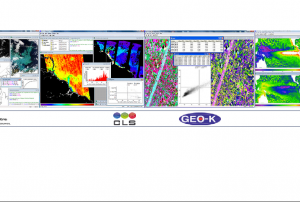Pollution
UN-SPIDER Regional Support Offices with hazard-specific expertise
Related content on the Knowledge Portal
- Publishing institution:
- Publishing institution:
- Publishing institution:
- A course from EUMETSAT and the Copernicus Atmosphere Monitoring Service/ECMWF. During the course you will discover the space, air and ground-based technologies we use to monitor and forecast the atmosphere by exploring how we observe and measure the atmosphere with satellites, ground-based and other forms of in-situ measurements, understanding the importance of satellite observations and other forms of measurements for atmospheric monitoring, investigating how atmospheric data is used in policy and decision-making, in a range of arenas, in conjunction with models and recognising the importance of the data for monitoring long-range transportation of pollutants in the atmosphere. You will explore the critical threats affecting the atmosphere and its composition - and how these affect human health, climate change and the ecosystem. You will also see how this all informs policy and international agreements, plus the extensive work needed to predict change and maintain air quality.
- The Ocean Virtual Laboratory is a web platform making satellite and in-situ data for ocean monitoring accessible. It presents one of multiple Syntool Web portals that promote the synergistic use of Ocean Remote Sensing data in a wider context of Oceanic and Atmospheric models or in-situ data. , ESA/SEOM Ocean Virtual Laboratory portal:
SAR roughness Sentinel 1:
Ocean Color: From Sentinel-2, Sentinel-3 and Meteosat.
Chlorophyll: From VIIRS and MODIS
Sea Surface Temperature, Sea level, Salinity, Wind, Current, Rain, Mean Square Slope, Sea ice concentration
, ESA/DUE GlobCurrent portal:
SAR roughness, Ocean Color, Chlorophyll, Sea surface temperature, Sea level, Salinity, Wind, Wave, Current, Rain, ESA SMOS Storm portal: Significant Wave height (SWH) Jason 2 and ALTIKA, SAR roughness Sentinel-1, Wind speed SMOS, SMAP, AMSR2 and ASCAT, wind barbs ASCAT, CNES Aviso'VIZ altimetry portal: Sea Surface Height Anomaly (SSHA) Jason-2 and SARAL, Sea Level Anomaly (SLA) Jason-2 and SARAL, Absolute Dynamic Anomaly (ADT) Jason-2 and SARAL, Mean Sea Level RIse, Sea Level Anomaly, Geostrophic current vectors and streamlines., ESA Sentinel3 Viewer: products from OLCI, SLSTR and SRAL sensors., CNES PEPS Sentinel-1 Ocean Viewer: SAR roughness Sentinel-1, ESA Sea Surface Salinity portal: SMOS salinity, SMAP salinityPublishing institution: - The Ocean Virtual Laboratory is a web platform making satellite and in-situ data for ocean monitoring accessible. It presents one of multiple Syntool Web portals that promote the synergistic use of Ocean Remote Sensing data in a wider context of Oceanic and Atmospheric models or in-situ data. , ESA/SEOM Ocean Virtual Laboratory portal:
SAR roughness Sentinel 1:
Ocean Color: From Sentinel-2, Sentinel-3 and Meteosat.
Chlorophyll: From VIIRS and MODIS
Sea Surface Temperature, Sea level, Salinity, Wind, Current, Rain, Mean Square Slope, Sea ice concentration
, ESA/DUE GlobCurrent portal:
SAR roughness, Ocean Color, Chlorophyll, Sea surface temperature, Sea level, Salinity, Wind, Wave, Current, Rain, ESA SMOS Storm portal: Significant Wave height (SWH) Jason 2 and ALTIKA, SAR roughness Sentinel-1, Wind speed SMOS, SMAP, AMSR2 and ASCAT, wind barbs ASCAT, CNES Aviso'VIZ altimetry portal: Sea Surface Height Anomaly (SSHA) Jason-2 and SARAL, Sea Level Anomaly (SLA) Jason-2 and SARAL, Absolute Dynamic Anomaly (ADT) Jason-2 and SARAL, Mean Sea Level RIse, Sea Level Anomaly, Geostrophic current vectors and streamlines., ESA Sentinel3 Viewer: products from OLCI, SLSTR and SRAL sensors., CNES PEPS Sentinel-1 Ocean Viewer: SAR roughness Sentinel-1, ESA Sea Surface Salinity portal: SMOS salinity, SMAP salinityPublishing institution: - Publishing institution:
- The World Water Quality Information and Capacity Building Portal (IIWQ) is a webmap that illustrates data on turbidity, chlorophyll-a, total absorption as well as the EOMAP specific harmful algal bloom indicator (HAB indicator). Where access to in-situ data is available station values are presented.Publishing institution:
- The World Water Quality Information and Capacity Building Portal (IIWQ) is a webmap that illustrates data on turbidity, chlorophyll-a, total absorption as well as the EOMAP specific harmful algal bloom indicator (HAB indicator). Where access to in-situ data is available station values are presented.Publishing institution:

